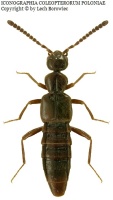
Русские, остановите эту войну! Спасите Свободную Украину!
Russians, stop this war! Save Free Ukraine!
Biodiversity Map
Taxa

Falagria — subordinate taxa:
Taxon count: 4
-
Falagria caesaSet as tree root ↑
Show taxon data → ⚑ [69] → Show taxon data
[69] → Show taxon data -
Falagria naevulaSet as tree root ↑
Show taxon data → [1] → Show taxon data -
Falagria splendensSet as tree root ↑
Show taxon data → [1] → Show taxon data -
Falagria sulcatulaSet as tree root ↑
Show taxon data → ⚑ [59] → Show taxon data
[59] → Show taxon data
-
Arthropodaphylum
Click to switch
to select orders
and filters > -
Hexapodasubphylum
Click to switch
to select orders
and filters > -
Insectaclass
Click to switch
to select orders
and filters > -
Coleopteraorder
Click to set
as the main taxon
and as a base
← of the left panel > -
Polyphagasuborder
Click to set
as the main taxon
and as a base
← of the left panel > -
Staphyliniformiaseries
Click to set
as the main taxon
and as a base
← of the left panel > -
Staphylinoideasuperfamily
Click to set
as the main taxon
and as a base
← of the left panel > -
Staphylinidaefamily
Click to set
as the main taxon
and as a base
← of the left panel > -
Aleocharinaesubfamily
Click to set
as the main taxon
and as a base
← of the left panel > -
Falagriinitribe
Click to set
as the main taxon
and as a base
← of the left panel > -
Falagriagenus
Click to set
as the main taxon
and as a base
← of the left panel >
PL
YES
name status: valid name
BioMap ID: 1009176
taxon code: 2021
taxonomy checked: YES
Data on distribution in Poland

Statistics
- Records: 69
- Publications: 44
- Collections: 7
- Publication authors: 41
- Illustrations (iconography): 1
- Photos (specimen/observation): lacking
Taxon description
Szeroko rozpowszechniony gatunek palearktyczny, występujący w całej Europie, a na wschód przez Syberię sięgający aż do Japonii. W Polsce prócz wyższych partii górskich występuje prawdopodobnie w całym kraju, aczkolwiek nie znany jeszcze z wielu krain, zwłaszcza południowych. Spotykany przeważnie na jesieni i wiosną w pryzmach kompostowych, pod gnijącymi grzybami i wyplewionym zielskiem, w napływkach; w zimie — w kretowiskach.
Illustrations
... browse
 Falagria
Falagriacaesa
External data sources
- Ostatnie rekordy
-
1020431
 ×
× Staphylinidae: Falagria caesa, Dźwiniaczka, 1938, coll. MiIZ PAN: Tenenbaum Sz.
Staphylinidae: Falagria caesa, Dźwiniaczka, 1938, coll. MiIZ PAN: Tenenbaum Sz. -
1020430
 ×
× Staphylinidae: Falagria caesa, Dźwinogród, 1938, coll. MiIZ PAN: Tenenbaum Sz.
Staphylinidae: Falagria caesa, Dźwinogród, 1938, coll. MiIZ PAN: Tenenbaum Sz. -
1020429
 ×
× Staphylinidae: Falagria caesa, Skolimów, 1937, coll. MiIZ PAN: Tenenbaum Sz.
Staphylinidae: Falagria caesa, Skolimów, 1937, coll. MiIZ PAN: Tenenbaum Sz. -
1020428
 ×
× Staphylinidae: Falagria caesa, Skolimów, 1937, coll. MiIZ PAN: Tenenbaum Sz.
Staphylinidae: Falagria caesa, Skolimów, 1937, coll. MiIZ PAN: Tenenbaum Sz. -
1020427
 ×
× Staphylinidae: Falagria caesa, Dźwinogród, 1937, coll. MiIZ PAN: Tenenbaum Sz.
Staphylinidae: Falagria caesa, Dźwinogród, 1937, coll. MiIZ PAN: Tenenbaum Sz. -
1020426
 ×
× Staphylinidae: Falagria caesa, Dźwinogród, 1937, coll. MiIZ PAN: Tenenbaum Sz.
Staphylinidae: Falagria caesa, Dźwinogród, 1937, coll. MiIZ PAN: Tenenbaum Sz. -
1020425
 ×
× Staphylinidae: Falagria caesa, Dźwinogród, 1937, coll. MiIZ PAN: Tenenbaum Sz.
Staphylinidae: Falagria caesa, Dźwinogród, 1937, coll. MiIZ PAN: Tenenbaum Sz. -
1020424
 ×
× Staphylinidae: Falagria caesa, Saska Kępa, 1937, coll. MiIZ PAN: Tenenbaum Sz.
Staphylinidae: Falagria caesa, Saska Kępa, 1937, coll. MiIZ PAN: Tenenbaum Sz. -
1020423
 ×
× Staphylinidae: Falagria caesa, Zegrze, 1937, coll. MiIZ PAN: Tenenbaum Sz.
Staphylinidae: Falagria caesa, Zegrze, 1937, coll. MiIZ PAN: Tenenbaum Sz. -
1020422
 ×
× Staphylinidae: Falagria caesa, Kupa, 1936, coll. MiIZ PAN: Tenenbaum Sz.
Staphylinidae: Falagria caesa, Kupa, 1936, coll. MiIZ PAN: Tenenbaum Sz. - ... more
- Powiązane publikacje
-
Ruta R., Melke A. 2011. Materiały do znajomości chrząszczy (Insecta: Coleoptera) rezerwatu przyrody „Kuźnik” koło Piły. Wiad. Entomol., 30(2):84-98.
 full text
full text Show records
Show records -
Mazur S., Borowski J., Łęgowski D., Perliński S., Skłodowski J. 2010. Monitoring wybranych grup stawonogów w Kampinoskim Parku Narodowym.
 Show records
Show records -
Ruta R. 2009b. Chrząszcze (Insecta: Coleoptera) Rynny Jezior Kuźnickich ze szczególnym uwzględnieniem rezerwatu „Kuźnik”. [In:] Owsianny P.M. (Ed.) Rynna Jezior Kuźnickich i rezerwat przyrody „Kuźnik” – Bioróżnorodność, Funkcjonowanie, Ochrona i Edukacja. Muzeum Stanisława Staszica, Piła. pp. 150-177.
 Show records
Show records -
Ruta R. 2007. Chrząszcze (Insecta: Coleoptera) kserotermicznych wzgórz Byszewickich w Dolinie Noteci. Nowy Pam. Fizjogr., 5:49-107.
 Show records
Show records -
Byk A., Mokrzycki T., Perliński S., Rutkiewicz A. 2006. Saproxylic beetles – in the monitoring of anthropogenic transformations of Białowieża Primeval Forest. [In:] Szujecki A. (Ed.) Zooindication-based monitoring of anthropogenic transformations in Białowieża Primeval Forest. Warsaw Agricultural University Press, Warsaw. pp. 325-397.
 Show records
Show records - ... more




